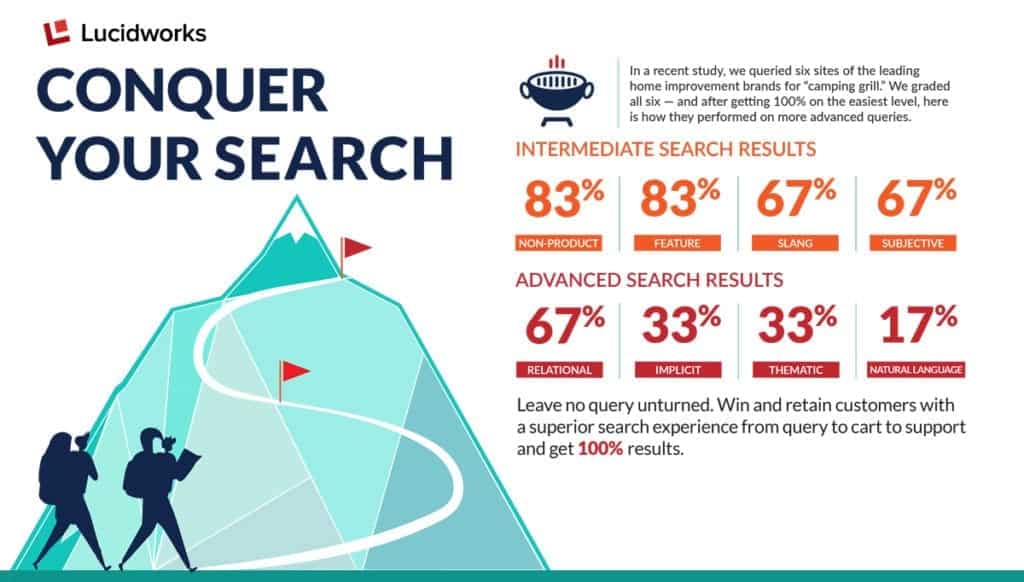Do You Know Your Customer’s Love Language?
I’ve been working in search engine development for a long time and while I know a lot, I don’t know your specific customer segment. And don’t assume you know your customer’s desires and preferences either! Turn to the data to stay up to date with ever-shifting preferences and needs.
By tracking metrics such as bounce rate, average order value, common search phrases, and add to cart rates, you can paint a more complete picture of how your unique customers prefer to shop. If you understand your shoppers’ behavior, you can make informed decisions about how to implement the following guidelines.
Keep Search Simple (and Smart)
As a famous playwright once wrote, a rose by any other name would smell as sweet. However, calling rain boots “shoe water blockers” probably won’t fly with customers. If they can’t find it, they won’t buy it. Make it simple to locate items based on your customers common lexicon — what they really call things. Track their queries over time to understand how they prefer to communicate.
Katharine McKee, founder of Digital Consultancy, advises, “Be truthful and honest about your product and what the market thinks it is. Be firm in your brand equity but know that how you wish to view your product can be unhelpful and lead to missed opportunities. For example, if no one calls your lip gloss a lip glaze, it’s pointless to continue using that term in search engine description.”
Another way to help customers find what they’re searching for is with synonym detection capabilities. For example, garbage bin, trash bin, waste basket are all common terms that refer to the same item. An effective search engine allows you to update your search beyond just a basic text match to capture (and optimize for) these common phrases.
Make Real-Time Recommendations
Research from Accenture and the Retail Industry Leaders Association (RILA) found that 63 percent of surveyed consumers are interested in personalized recommendations. According to Salesforce, 6 percent of ecommerce visits that include engagement with AI-powered recommendations drive 37 percent of revenue. Those numbers are too big to ignore.
By tracking customer signals including what they click on, what they ignore, and what they call things, you can understand their likes and dislikes, as well as their intent, to capture that additional revenue.
Understand the 12 Common Query Types
There are more than 7,000 languages spoken around the world. Luckily, there are only 12 common query types. Let’s take grill shopping as an example. A slang query would be “bbq.” A subjective query would be “top rated weber grill.” A natural language query could be “grills that are good for parties.” Different ways to search, but all hunting for the same result.
In a recent survey of top home improvement brands, we discovered that only 17 percent were able to deliver relevant results for the trickiest searches (a natural language style search), followed by a small 33 percent for the 2nd and 3rd most advanced query types. I’d recommend testing your own website using our guide to see where you can improve, and ensure that you’re succeeding at the easy and intermediate query types.

Text searches aren’t the only ones you should be thinking about. Leading retailers like Neiman Marcus, are throwing their weight behind improving visual search capabilities. According to RetailDive, their “Snap. Find. Shop.” function enables users to enter a 3D image and have suggestions of visually similar products delivered instantaneously. Data supports their investment: 56 percent of consumers say they would be interested in such capabilities and 84 of the 100 retail executives claim image commerce — snapping a photo to initiate a visual search — is important for their future success.
Meet Customers’ Expectations
Customer experience is used as an umbrella term that captures all of the interactions consumers have with brands — product offerings, price, support, website navigability, and on and on. Today, 89 percent of organizations are already competing on customer experience, with 76 percent of consumers seeing customer experience as a clear indicator of how much your company values them. But it can be tough to know where to start.
According to a study from Infosys, 74 percent of consumers get frustrated with product information that’s not personalized. Start there! The search bar is ubiquitous, it’s the first thing users turn to when they want to browse, get support, or find the return policy.
Understanding your customers’ search language and behavior is a critical step to building a better experience. Listen to what they have to say, and you’ll have a long, happy life together.
Interested to see how you stack up against the competition? Check out a recent benchmark survey report on personalization and site performance among some of the top $100M plus retailers.
The original version of this article was published on MarTech Advisor.